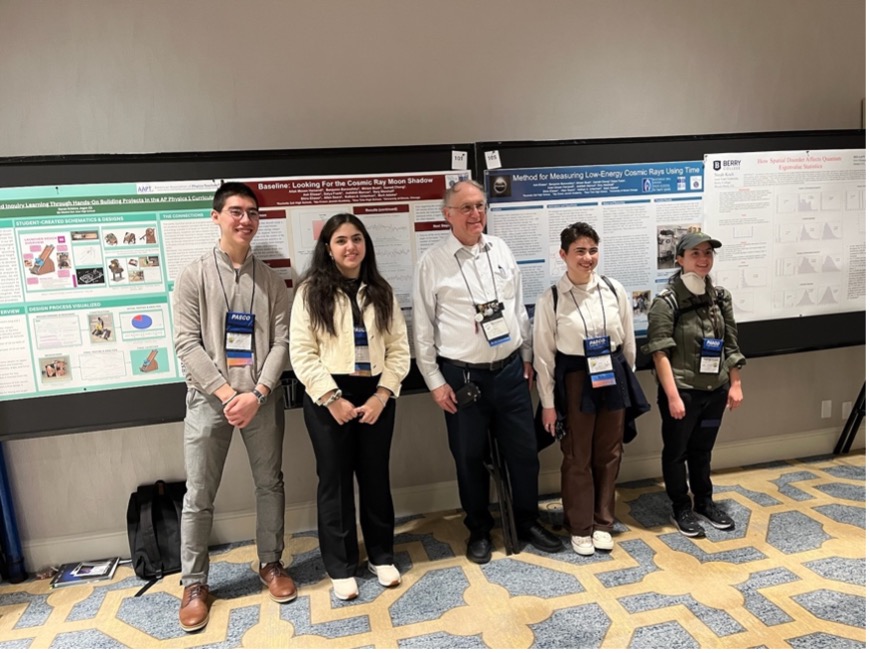UIC-CSU Annual Report 2023-2024
Report of QuarkNet Activities at UIC and CSU during 2023-2024
The QuarkNet Program at the University of Illinois at Chicago and Chicago State provides mentoring, organization, and collaborative structure to students and teachers at seven Chicagoland high schools that host cosmic ray detectors. UIC-CSU has provided detectors so that schools can carry out physics experiments based on the detection of cosmic ray muons. Three major research projects were carried during this period. Eight half-day meetings were held throughout the year at New Trier High School. The 2024 summer workshop August 6-8, focused on analyses of CME data, was held at Downers Grove South High School.
Moon Shadow; Eclipse; CME
Moon Shadow
During the year, teachers at four locations have collected data to attempt to measure the shadow of the moon cast in muons at the Earth’s surface. Each research group fixed the orientation of telescopes at a unique zenith angle (70, 60, 55, and 26 degrees) at each school. This avoided tracking the moon’s position at its meridian crossings, however, the moon was in the acceptance of each telescope only 8-10 days per month. This project addresses the largest uncertainty in upper limits of muons coming from the Sun determined in our 2017 eclipse project and will inform our 2024 Eclipse effort. No astronomy group has reported an observation of the shadow at low energy. Student talks and posters covered a description of the technique and the report of an upper limit at the Jan. 2024 AAPT meeting in New Orleans. Their posters won an award for second best undergraduate poster!

Students presenting poster on the Moon Shadow experiment along with lead teacher Unterman.
Total Solar Eclipse 2024
The group designed an experiment to collect large array data to select cosmic ray muons from higher energy cosmic rays during the total eclipse in April 2024. This approach complemented their measurement from the 2017 eclipse. Students and teachers traveled twice to the area of totality, once in March 24-25 to set up six CRMDs in triangular patterns with varying counter separations, and again April 7-8 during the eclipse. Operation of six separate readout systems in a barn was challenging, however, all detectors functioned flawlessly during the eclipse period. Parents transported students and participated with detector configuration. Analysis of the data was carried out over five half-day sessions at New Trier High School. Two posters were created summarizing the technique and presenting upper limits on cosmic rays from the Sun as a function of counter separation (correlated with cosmic ray energy). Unterman presented initial results at the AAPT Boston meeting on July 8th.

Eclipse research group included students from three high schools.

Image of draft poster summarizing the 2024 Eclipse-Cosmic Ray Experiment
CME – A large coronal mass ejection in May caused auroras through the world. It also disturbed the Earth’s magnetic field thus decreasing the muon rate on the surface. During several analysis half-day sessions at New Trier and Downers Grove South students observed a large signal in the cosmic ray muon rate in two detectors. CME analysis was the theme of the summer workshop. Students measured the flux of all 25 QuarkNet detectors active in the US during May 2024. Ten detectors were deemed stable enough to measure the muon rate changes due to CME. Almost all signals of a drop in muon rate were observed to turn on with 30 minutes of each other and recovered over a 4-day period. During the workshop some data was corrected for rate changes due to atmospheric pressure, which improved the sensitivity. At a follow-up half-day analysis meeting a procedure was developed and data from several CRMDs were corrected for pressure. Students plan to finish correcting all data sets and to meet again in September to complete the analysis.
Unterman has also obtained funding from his school to build two radio telescopes The group plans to correlate cosmic ray air shower signals from radio horns and the existing scintillation counter detectors.
Workshops:
Initial results were for the moon shadow experiment were obtained at last year’s summer workshop on June 14-15, 2023. Half-day Sunday moon shadow analysis workshops during the Fall 2023 completed the analysis, leading to presentations at AAPT in January 2024.
The 2024 summer workshop met August 6-8 at Downers Grove South High School and completed a set of cosmic ray measurements from data obtained during a CME event in May. Three teachers, nine students and both mentors attended the workshop. In addition to CME activity, they debugged several detectors (CRMDs) and carried out a measurement of the muon speed using scintillation counters located on the ground and second floor.
Unterman and Adams continue to collect standard data sets for cosmic ray analyses in e-Lab for QuarkNet groups who don’t have a detector. These were created for teachers to use with their classrooms throughout the country originally during the pandemic and remain very popular.
Pyramid
Garcia is principle investigator of an experiment that is building a scintillation tracker to image the interior of the pyramid at Chichen Itza. Data is hosted on QuarkNet’s e-Lab; available to all users. We anticipate that high schools in the UIC-CSU Center will participate in the calibration process during the next academic year. Some early calibration data at the pyramid may also be used to improve the sensitivity of the moon shadow measurement.
Mark Adams UIC Professor Emeritus of Physics
and
Edmundo Garcia- Solis CSU Physics Professor
Associate Provost of Research and Grant Administration
References:
UIC QuarkNet Center talks at AAPT Jan. 2024 – New Orleans
Adams, “High Energy Physics Experiments in the Classroom”, AAPT in New Orleans, January 7, 2024.
Students: Miriam Bush and Ash Eliaser, “Use of Time to Measure Momentum/Energy of Cosmic Rays”, AAPT in New Orleans, January 7, 2024.
Students: Garrett Chong and Aytak Harzandi, “Finding the Moon’s Cosmic Ray Shadow Signal”, AAPT in New Orleans, January 7, 2024.
Teacher: Nathan Unterman, “Cosmic Ray Experiments Using Local Sites and Resources Cosmic Ray Studies in the Classroom”, AAPT in New Orleans, January 7, 2024.
QuarkNet high school students also presented two posters which came in second place in the AAPT undergraduate poster contest.
SPS Poster Session (6–7 p.m.) Saturday
SAT-SPS-101 | Poster Presentation Traditional | Baseline: Looking For the Cosmic Ray Moonshadow
Presenting Author: Aitak Mosen Harzandi, New Trier High School Co-presenting Author | Garrett Chong, New Trier High School Co-presenting Author | Benjamin Baronofsky, Ida Crown Jewish Academy Co-presenting Author | Jedidiah Marcus, Ida Crown Jewish Academy Additional Author | Nathan A. Unterman, New Trier High School
Using multiple detectors set at different angles of elevation, the schools in the collaboration observed a large portion of the sky, collecting muon data to look for the moon’s cosmic ray shadow. Each school used one of four angles of elevation, each producing their own sets of data and graphs for each day. These graphs were combined into monthly, then yearly averages. These four graphs were then analyzed and compared to find a consistent dip in muon count, which would hint at the presence of a cosmic ray shadow. The data are consistent with no signal, so an upper limit was determined to guide future experiments.
SAT-SPS-105 | Poster | Method for Measuring Low-Energy Cosmic Rays Using Time
Presenting Author: Ash Eliaser, Rochelle Zell Jewish High School Co-presenting Author | Miriam Bush, Rochelle Zell Jewish High School Co-presenting Author | Dalya Frank, Rochelle Zell Jewish High School Co-presenting Author | Dory Marshall, Ida Crown Jewish Academy Additional Author | Nathan A. Unterman, New Trier High School Additional Author | Allen Sears, Ida Crown Jewish Academy
A collaboration of high school students set up cosmic ray detectors to measure low-energy cosmic rays using time with the goal of locating the moon’s cosmic ray shadow. The detectors were arranged at different elevation angles aiming south to capture the moon’s passage each day. As Earth rotates, the detectors swept the sky daily. Lower energy primary cosmic rays bend more due to magnetic fields and should be found as a shadow well before the moon crosses the meridian. The shadow was not expected after the moon passed the meridian since there are almost no anti-protons in the primary rays. Experiment methods are discussed in this poster.
SUN-DA-01 (3:00 to 3:12 PM) | Contributed Talk | Use of Time to Measure Momentum/Energy of Cosmic Rays
Presenting Author: Miriam Bush, Rochelle Zell Jewish High School Co-presenting Author | Dalya Frank, Rochelle Zell Jewish High School Co-presenting Author | Ash Eliaser, Rochelle Zell Jewish High School Co-presenting Author | Dory Marshall, Ida Crown Jewish Academy Additional Author | Nathan A. Unterman, New Trier High School Additional Author | Allen Sears, Ida Crown Jewish Academy
During the total eclipse of 2017, students reported that the anticipated cosmic ray shadow was not in line with the moon (and sun)1. It was suggested that the lunar shadow may be elsewhere in the sky. An experiment was designed to look for the cosmic ray lunar shadow to the west and east of the Moon to account for effects from the Earth’s magnetic field. Low energy primary cosmic rays would be bent more than those of higher energy. This allowed the experiment to use time ahead of lunar meridian passage to measure a range of cosmic ray energies—a novel approach. The design of such an experiment will be discussed.
(1) Dallal, Tamar A., et al.; Solar Eclipse and Cosmic Ray Flux, The Physics Teacher, volume 60, pp 100-104. February 2022
The SUN-DA-03 (3:24 to 3:36 PM) | Contributed Talk | Cosmic Ray Experiments Using Local Sites and Resources
Presenting Author: Kenneth Boldt, La Cueva High School, Albuquerque, NM
Co-presenting Author | Nathan Unterman, Del Norte High School, Albuquerque, NM
With modest investments in equipment, students may conduct cosmic ray experiments employing local topologies such as tall buildings, trams, mountains, and similar. This report centers on a trip up and down Sandia Mountain in Albuquerque, NM, experiment design, necessary arrangements, execution, and results. Nathan Unterman will present if the other authors do not get funding to attend. All email should be directed to him.
SUN-DA-04 (3:36 to 4:00 PM) | Contributed Talk | Finding the Moon’s Cosmic Ray Shadow Signal
Presenting Author: Garrett Chong, New Trier High School
Co-presenting Author | Aitak Mosen Harzandi, New Trier High School
Co-presenting Author | Benjamin Baronofsky, Ida Crown Jewish Academy
Co-presenting Author | Jedidiah Marcus, Ida Crown Jewish Academy
Additional Author | Nathan A Unterman, New Trier High School
Additional Author | Allen Sears, Ida Crown Jewish Academy
Using four stacked muon detectors oriented at different elevation angles to the sky across the Chicagoland area, a collaboration of high school students measured the baseline cosmic ray signal as a function of the moon’s position. Our results are consistent with the background data, and showed no definitive lunar shadow signal. Measurements with improved angular resolution are required to reduce the background of cosmic rays not blocked by the Moon. The collaboration’s goal is to have a conclusive picture of the baseline cosmic rays in preparation for the solar eclipse of April 8, 2024.
UIC QuarkNet Center talk at AAPT July 2024 - Boston
Nathan Unterman, “Cosmic Ray Shower Studies by High School Students – Design Through Execution”, AAPT in Boston, July 8, 2024.
